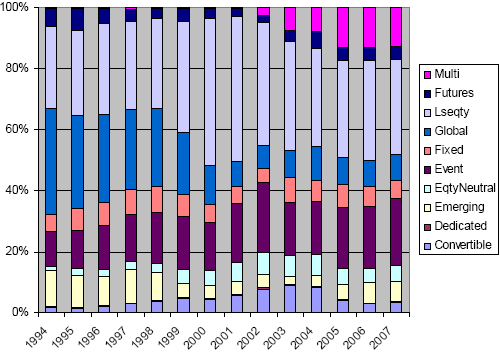Are presumably sophisticated (or at least wealthy) hedge fund investors on the whole past return chasers or future return finders? In their November 2007 paper entitled “Aggregate Hedge Fund Flows and Asset Returns”, Ashley Wang and Lu Zheng answer these questions in aggregate by analyzing the overall flow of money into and out of hedge funds. They also examine separately flow patterns for ten hedge fund categories: convertible arbitrage, dedicated short bias, emerging markets, equity market neutral, event driven, fixed income arbitrage, global macro, long/short equity, managed futures and multi strategies. Using quarterly hedge fund flow and return data across the ten fund categories from first quarter 1994 to first quarter 2007, they find that:
- The average raw quarterly hedge fund return over the sample period is 2.94%, compared to 3.08% for the broad U.S. stock market. The global macro and long/short equity hedge categories have the highest average raw quarterly returns, while dedicated short bias has the lowest. In aggregate, hedge fund returns exhibit high correlation with broad U.S. stock market returns (+0.58), with the dedicated short bias category a notable exception (-0.78).
- The typical hedge fund has an average quarterly inflow of 2.77% over the sample period, with large variations across fund categories.
- Aggregate hedge fund flows relate:
- Positively to past aggregate hedge fund returns, indicating that hedge fund investors as a group chase past performance. This pattern is most pronounced for the dedicated short bias, equity neutral, fixed income arbitrage and long/short equity categories.
- Positively to contemporaneous aggregate hedge fund returns, suggesting that new hedge fund investments drive up the prices of underlying assets. This pattern is most pronounced for the convertible arbitrage, emerging market, event driven, fixed income arbitrage, global macro and long/short equity categories.
- Slightly negatively to future aggregate hedge fund returns, suggesting that hedge fund investors as a group do not successfully time their investments.
- Negatively to past return volatility, but this relationship is significant only for the event driven, global macro and multi strategy categories.
- Positively (negatively) to past stock market (Treasury bill) returns, but stock and bond market returns are unrelated to past aggregate hedge fund flows.
- The positive correlation between fund flows and past (contemporaneous) returns exists only in down (up) markets, perhaps reflecting withdrawal restrictions and/or an increase in investor risk-averseness after market declines.
The following figure, excerpted from the paper, summarizes distribution of assets by hedge fund category from the beginning of 1994 to the beginning of 2007. The fund category key is as follows: Convertible=convertible arbitrage; Dedicated=dedicated short bias; Emerging=emerging markets; Eqtyneutral=equity market neutral; Event=event driven; Fixed=fixed income arbitrage; Global=global macro; LSeqty=long/short equity; Futures=managed futures; and, Multi=multi strategies. One notable trend is the displacement of global macro and perhaps long/short equity by multi strategies.

In summary, presumably sophisticated hedge fund investors as a group chase past returns and fail to time their investments successfully.
Investors may want to consider this evidence when timing their own investment flows.